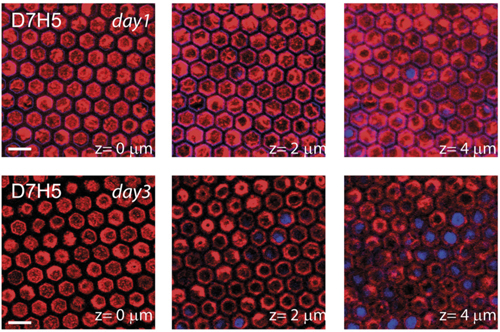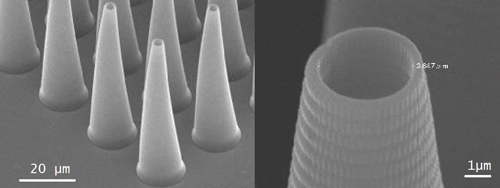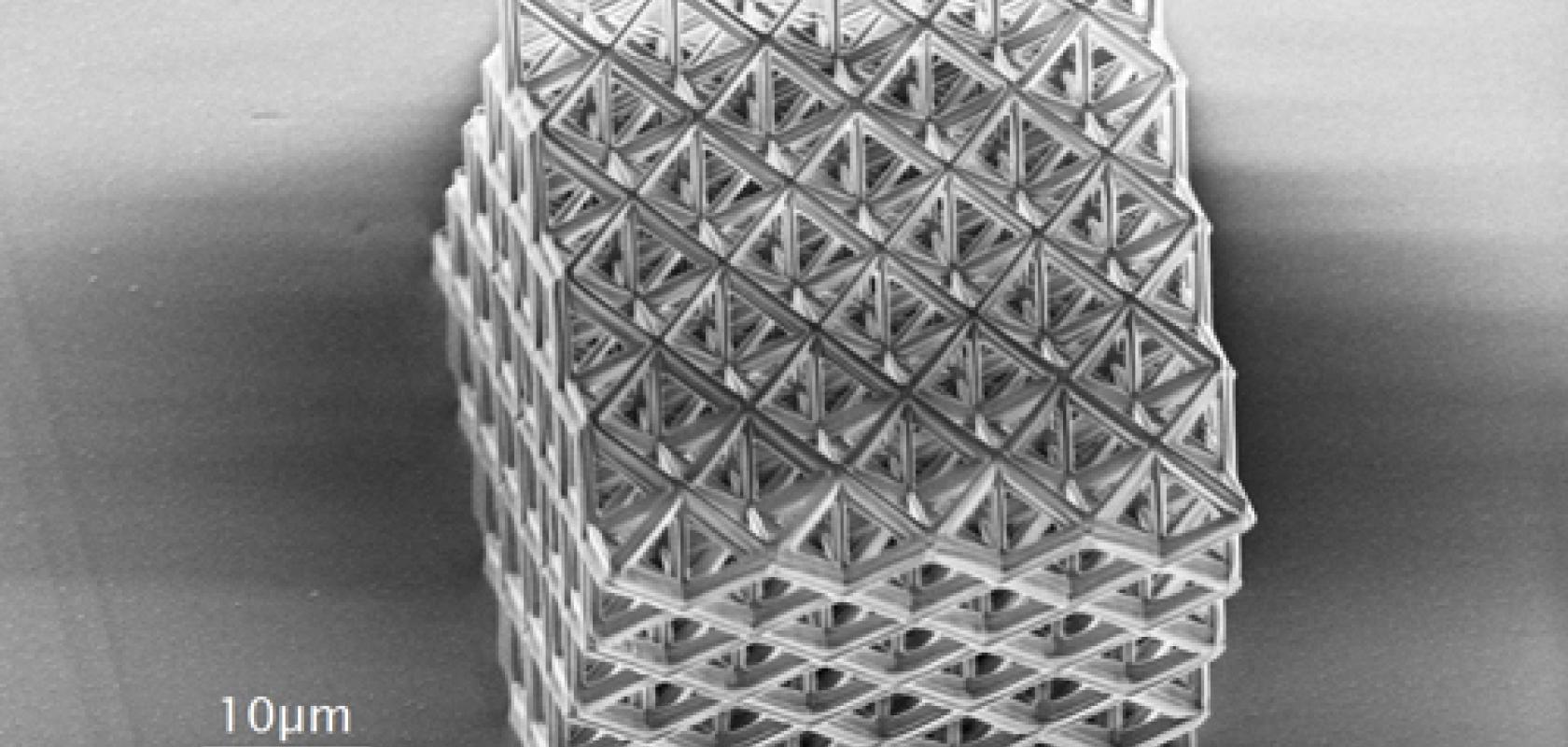Formnext, the additive manufacturing trade fair, covered the full range of 3D printing methods and technologies in Frankfurt recently, most of which use a layer-by-layer approach to build up an object. Two companies, however, have commercialised a two-photon polymerisation technique, whereby a laser pulse prints directly inside a vat of photo-polymer material. This method is not constrained to making objects in layers and can print extremely small structures, down to 0.2µm, small enough for tissue engineering or creating shapes inside microfluidic channels.
Nanoscribe is the older of the two, spun out of research from the Karlsruhe Institute of Technology in Germany in 2007, now with 60 employees. French firm Microlight3D was incorporated two years ago after 15 years of research and development at the University Grenoble Alpes, under the direction of co-inventors Patrice Baldeck and Michel Bouriau. Bouriau and Denis Barbier, formerly CTO of Teem Photonics, led the transfer of the technology from the lab to Microlight3D.
Since 2016 Microlight3D has sold machines to researchers investigating cell culture and tissue engineering, but is also now targeting industrial applications such as printing micro-optics or micro-connectors, micro-sensors and micro-robotics.
Two-photon polymerisation can achieve a resolution of at least 100 times better than standard 3D printers, noted Barbier, CEO of Microlight3D, speaking to Electro Optics.

Epithelial cells culture on 3D micro-printed alveolar architecture. Credit: S. Coscoy et al
The technique is based on a nonlinear optical effect that occurs at the focal point of the laser beam. Photopolymerisation transforms a monomer material into a polymer, but only at the laser’s focal point. Therefore, with careful control of the focus, the laser writes the shape directly into the material.
‘The key point is that we can move the focal point freely inside the liquid monomer without following the standard layer-by-layer approach,’ explained Barbier. ‘We have no limitation in shape.’
Microlight3D’s technology uses a picosecond pulsed laser emitting green light at 532nm. The company decided to go with a visible wavelength in order to print even smaller features than would be possible with an infrared laser.
The technique can work with any pulse duration below 1ns, according to Barbier, although Microlight3D’s system operates around 100ps. For two-photon polymerisation to work, the material needs to be transparent at the laser wavelength (532nm for Microlight3D’s technology). The material also has to have an absorption band in the UV, at 266nm for Microlight3D. This is mandatory, but not always sufficient, Barbier said – in some cases a photoinitiator is added to the material, to improve performance and make the material compatible with the process. Microlight3D has developed its own photoinitiator.
The company has supplied its technology to researchers studying tissue engineering. The machine is able to print micro-scale scaffold from collagen or biocompatible polymers onto which cells are grown. ‘We print the scaffold with a resolution that is below the size of the cells,’ explained Barbier. ‘The cells then grow inside the scaffold. The idea is that – with our resolution and precision – the scientists can really print any 3D shape they want.’

Automatic large area micro-manufacturing of micro-needles for drug delivery. Credit: T.T. Chung et al
The scaffold will vary according to the tissue, whether that’s artificial skin or blood vessels. ‘Scientists can be really precise in reproducing living tissue,’ he added.
Microfluidics for analytical devices is another area where Microlight3D’s technology has interest, especially to create small structures inside microfluidic channels, which are typically 100µm to 200µm diameter. Microfluidic devices, such as those for DNA analysis, contain very small channels that are able to control the movement of fluids extremely precisely. ‘We can print inside these [microfluidic] channels because our resolution is down to 0.2µm. We can make small structures that are 10µm in size inside the channels,’ Barbier explained.
‘We’ve also had a lot of interest from engineers working on micro-robotics,’ he added. One potential futuristic use of these tiny machines might be to transport drugs inside the body. ‘Our machine has been bought by researchers that work in this field,’ Barbier said.
Customers working on micro-optics, micro-connectors, and micro-sensors, are also interested in the technology.
The typical surface finish of two-photon polymerisation at high resolution is 20nm roughness, which, according to Barbier, is good enough for most optical applications. The high-quality surface finish also means that the part doesn’t require post-processing, as is often the case when manufacturing objects with traditional 3D printing. Once printing is finished using two-photon polymerisation, the remaining monomer is washed out with a solvent.

Denis Barbier, CEO of Microlight3D, was formerly CTO of Teem Photonics for 18 years
The technique’s precision means printing large, complex parts will take a long time; it’s advisable to use the high printing resolution only where it is needed. Microlight3D’s system is able to vary the size of the laser beam in order to print faster when necessary. The printing speed is also linked to the software, which in the case of Microlight3D is designed to optimise the laser path to make the part reproducible to the model, but also to maximise the speed.
‘Software plus laser beam optimisation allows us to go as fast as possible,’ Barbier said. ‘But it still takes time if you want to print in high resolution.
‘Our goal is to increase the speed to bring this technology towards industrial applications,’ he continued. To make an industrial system requires both hardware and software improvements, according to Barbier. At the moment the product is dedicated to research, meaning it is open so that researchers can add code to the software and adjust the machine to suit their needs. Industrial products, however, tend to be dedicated to one process.
‘If we want to print small mechanical parts we have to be dust-proof, for example, and also the way the parts are manipulated will be different,’ explained Barbier.
‘All of that is for the future,’ he concluded. ‘In the short-term, we will introduce our first industrial machine early next year.’
Top image: Micro-scaffolds printed by two-photon polymerisation

